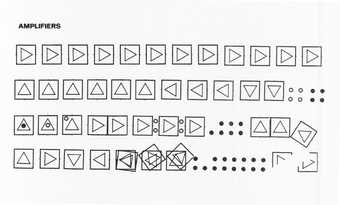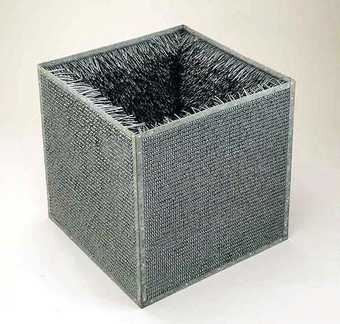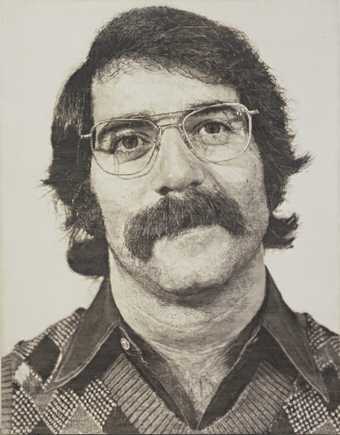Simultaneous with the early exhibitions of Jennifer Bartlett’s plate pieces in 1972 at Reese Palley and in 1973 and 1974 at the Paula Cooper Gallery, both in New York, the artist was writing her autobiography, History of the Universe (published in 1985).1 She had published a volume of poetry in 1971, Cleopatra I–IV (fig.1),2 which combined ‘chronology, historical genre, sexual metaphors, aphoristic sentences, and … an array of diagrammatic signs in systematic rows’, according to the critic Max Kozloff.3 Kozloff understood the diagrams and systems in Bartlett’s 1974 exhibition of plate works at the Paula Cooper Gallery in terms of the diagrams in Cleopatra I–IV, which were ‘amplified in her paintings’.4 Bartlett gave readings of her poetry and autobiography at venues associated with avant-garde performance, such as the church of St Mark’s-in-the-Bouwerie in New York, as well as at galleries where her plates were displayed, including at Paula Cooper in 1973.

Fig.1
Illustration from Cleopatra II, published in Jennifer Bartlett, Cleopatra I–IV, New York 1971, unpaginated
History of the Universe is ‘a kind of non-stop, precise inventory of personal events and habits’, one reviewer noted in 1973.5 When Bartlett mentions her artistic practice in the autobiography, descriptions are woven into other factual accounts of her life. Like the nouveau roman, the work reads as a free associational flow of memory and perception:
I have a family and a great many friends. For my work I use Testor Pla paint enamel, #4 sable brushes, 16-gauge steel plates with a baked enamel surface, quarter-inch grid silkscreened on, and Xylol thinner. My rent is $195 per month, I pay a $73 loan payment. I teach for a living.6
Bartlett continues in this passage to report on other subjects such as masturbation and her education. History of the Universe suggests a kind of complete exposure of the self, free of censorship or hierarchy: a montage of personal, erotic and cultural references. The work seems unmediated and unedited, unconcerned with conventional strictures of plot and organisation. Such raw, experiential expression would have been particularly affecting in live readings. Bartlett’s autobiographical writing tempts association with her plates in works such as Surface Substitution on 36 Plates 1972 (Tate T06637), with their repetitive marks of the artist’s presence and non-hierarchical organisation.
Labour and repetition

Fig.2
Eva Hesse
Accession II 1969
Detroit Institute of Arts, Detroit
© The Estate of Eva Hesse
At some point in the early 1970s Bartlett showed her work to Sol LeWitt – a figure whose influence she has repeatedly cited, particularly his writings. LeWitt ‘Sentences on Conceptual Art’, published in 1969, was, in Bartlett’s estimation, ‘the best art thing … written, and also probably one of the great poems of the late twentieth century’.7 LeWitt did not especially care for Bartlett’s work, she recalled, yet there was an aspect that he appreciated: her process of dotting plates ‘was something I could do virtually endlessly and to the abyss. And he thought the same way about my writing. He said “why you decided to write about this is that [you] could go on endlessly doing it and it would have some interest”, which is true’.8 LeWitt, in Bartlett’s account, pointed to the form of both her dotted plates and her autobiography as the interesting quality: its virtual endlessness even to the point of nihilism. Artists that LeWitt was known for admiring, such as Eva Hesse, also took repetitive processes to absurd extremes. For her Accession series (five works made in 1968–9) Hesse hand-threaded tens of thousands of pieces of vinyl extrusion through the perforated walls of fabricated metal boxes, merging arduous handiwork with a manufactured object, as Bartlett did with her plates (see Accession II 1969; fig.2). In both cases, the objects gain significance through such accretion of labour; handiwork gives visible evidence of the artists’ physical and psychological investment.

Fig.3
Sol LeWitt
Wall Drawing 1: Drawing Series II 18 (A & B), October 1968
SFMOMA, San Francisco
© The LeWitt Estate
LeWitt was an enormously influential figure in the New York art world, both for his writings on conceptual art and for the strategies he employed in his own practice. He began drawing directly on the wall in 1968, the year Bartlett adopted steel plates (see, for instance, LeWitt’s 1968 work Wall Drawing I: Drawing Series II 18 (A & B); fig.3). Bartlett credits LeWitt for introducing her to Jo Watanabe, the Brooklyn printmaker who silkscreened her plates with grids. As nearly flat surfaces installed flush with the wall, like signage, utilising borders of wall as ‘frames’ between each plate, Bartlett’s plate pieces also integrate the wall, although not as radically as LeWitt’s drawings, which employed the wall itself as their support. For his first drawing, LeWitt drew thousands of lines on a wall at the Paula Cooper Gallery; anyone wanting to buy the work would have to pay for it ‘per hour’, according to the exhibition pricelist, highlighting labour as constitutive of his wall drawings’ significance. Like Bartlett’s process of dotting her plate pieces, LeWitt’s drawings often required a kind of extreme duration that was integral to the work’s effect and meaning. Yet aside from this first drawing, LeWitt outsourced most labour in the creation of his art. Technical draughtsmen executed his subsequent wall drawings according to his instructions, and his structures were factory-made.
The draughtsmen to whom LeWitt outsourced the execution of his wall drawings could spend days or weeks repeating the same simple gestures. As LeWitt wrote in 1970:
The draftsman and the wall enter a dialogue. The draftsman becomes bored but later through this meaningless activity finds peace or misery. The lines on the wall are the residue of this process. Each line is as important as each other line. All of the lines become one thing. The viewer of the lines can see only lines on the wall. They are meaningless. That is art.9
Meaninglessness and boredom – pushing a process to an extreme such that it registers the psychic or physical limits of artist, draughtsman or viewer – became an important concept in the art world at this time. Work that involved this kind of mind-emptying repetition had multiple cultural associations in the 1970s: with women’s work such as knitting or embroidery, the meditative silence and repetition of Buddhist rituals, or the strings of 0s and 1s that comprised computerised processes. Bartlett dotted her plates herself, and her autographical involvement in the labour was essential. Unlike LeWitt’s use of draughtsmen, it could not be outsourced or machine-produced. The aspect of ‘peace or misery’ that LeWitt identified in the execution of his wall drawings was an important component of Bartlett’s plates, with their visible record of prolonged labour.
Marking time

Fig.4
Joel Shapiro
Fingerprint Drawing 1969
Ink on paper
1634 x 3435 mm
Museum of Modern Art, New York
The recording of actions or processes, and hence the marking of time, was part of the significance of the work of many artists in Bartlett’s milieu of the late 1960s and early 1970s, including figures with whom she had become closely connected at Yale. Joel Shapiro engaged in repetitive mark making in his drawings, such as the large-scale Fingerprint Drawing 1969 (fig.4) in which the artist’s fingerprint is stamped thousands of times in neat rows across an expansive piece of paper. Ideas about painting expanded on pop art, making it more personal and even obsessive, as in the case of Bartlett’s Yale classmate Chuck Close, who utilised grid systems to meticulously render highly realistic large-scale portraits of friends, such as Robert/104,072 1973–4 (fig.5). The work of others opened up into installation practices through their scale. As Bartlett said of her use of plates, ‘I liked the idea of having a painting go around a corner’, in the same way as Richard Serra’s work that would involve ‘a tall slab in a corner’.10 There was a desire to make simple, immediate work: ‘Richard [Serra] wanted to make the dumbest sculpture he could, something that didn’t depend on a sophisticated or artful manipulation of the materials’, Close recalled. ‘We all wanted to de-artify our work, to make something that didn’t look like art.’11 Many of these artists (although not Serra) rejected the outsourcing of labour that was common practice among minimalist and conceptual artists, undertaking personal, durational acts that resulted in accumulations of forms or objects.

Fig.5
Chuck Close
Robert/104,072 1973–4
Synthetic polymer paint and ink with graphite on gessoed canvas
2744 x 2134 mm
Museum of Modern Art, New York

Fig.6
Jonathan Borofsky
Counting 1969–
Installation view from the exhibition McArthur Binion, Jonathan Borofsky, Mary Obering, Artists Space, New York, 1973
© Jonathan Borofsky
Photo: Jim Strong
Bartlett is often paired with the artist Elizabeth Murray in art historical discussions, due to their friendship, their gender and the fact that both were painters, but as Bartlett noted in a 1989 interview, ‘I share much more with an artist like Jon Borofsky’. In particular, ‘the more minimal ones like the Counting Stack’ (begun in 1969 and referred to by Borofsky as Counting) were works to which she related, stating further that ‘he’s always been an interesting artist to me’ and was an ‘immediate friend’.12 With Counting Borofsky set out to reach infinity, counting for several hours a day and marking his progress on graph paper. When he exhibited a column of filled graph paper at Artists Space in New York in 1973, his count had reached 1,800,000 (fig.6). His artworks are numbered, locating them within the progress of his count. For instance, drawings by Borofsky in the Tate collection are titled with both words and numbers, as in his Untitled at 2,436,185 c.1977–8 (Tate T03917) and I Dreamed I Could Fly at 2,518,124 c.1977–8 (Tate T03916). Borofsky’s best-known series of towering steel Hammering Man sculptures, begun in 1979, extend this marking of time and labour: these mechanised kinetic sculptures slowly but incessantly perform their work, millions of rote movements, decade upon decade (see, for instance, Hammering Man 1990, permanently installed outside the Messeturm building in Frankfurt).
From the logical to the irrational
Although conceptual art, which utilises systems, and process-based art, which emphasises the repetitive act of making, may seem antithetical, the overlapping of these domains in the work of Bartlett, Borofsky, Hesse, Lynda Benglis and many other artists working in New York in the late 1960s and early 1970s yielded rich and paradoxical possibilities. The digitisation of thought and the mechanisation of labour, human persistence in the face of existential pointlessness – these were irreducible, even irrational, kinds of content to take on. Bartlett’s plate pieces were somatic philosophical engagements: an embodied, durational engagement with systems, perhaps the binary codes of the emerging digital age.13 Rational thought met with human inconsistency when applied in the world – as Bartlett’s embrace of accidents seems to illustrate.
‘The idea becomes a machine that makes the art’, LeWitt famously stated in his ‘Paragraphs on Conceptual Art’ (1967). He was quick to point out, however, that ‘This kind of art is not theoretical or illustrative of theories; it is intuitive, it is involved with all types of mental processes and it is purposeless’.14 In 1969 LeWitt articulated this position even more clearly. The first of his ‘Sentences on Conceptual Art’ read: ‘Conceptual artists are mystics rather than rationalists. They leap to conclusions that logic cannot reach.’15 Artists such as LeWitt staged a tension between the rational, bureaucratic logic of systemic organisation and the perceptual and intellectual contingencies of artist and viewer.
Bartlett used mathematical systems to structure many of her plates, including Surface Substitution on 36 Plates, but what was her commitment to mathematical concepts like the Fibonacci series? Mathematics was never important in itself, Bartlett communicated to the critic Calvin Tomkins on the occasion of a New Yorker profile in 1985. It was, rather, ‘a means of getting work done. The benefits came from the physical act of applying paint, not from the system.’16 In other words, the system provided a structure, but it may not necessarily even be followed through in the case of a work like Surface Substitution. Bartlett’s gallerist, Paula Cooper, was at one point frustrated by ‘her blithe way of following a mathematical system until it became inconvenient and then bending it or simply dropping it’, accusing Bartlett of being a ‘nihilist’ in this respect.17 For Cooper, whose gallery exhibited LeWitt’s first wall drawing, conceptual art grounded in systems of information meant that ‘you were involving yourself in an investigation that became … the content of the work’; hence to break the system, as Bartlett claimed to do, seemed problematic to Cooper.18 Yet Bartlett’s inconsistency might be better understood as an artistic choice that reveals a scepticism towards mathematical systems per se, even an upending of the rational logic of systems. After all, as illustrations of mathematical systems, what do works like Surface Substitution offer the viewer? According to artist and musician Laurie Anderson in her review of Bartlett’s 1972 solo exhibition at Reese Palley, the systems were only ‘marginally logical visually’.19
Bartlett has been adamant that while the ‘numerical systems where each number expands in a certain kind of way’ are the subject of a painting, such systems are not the content. She used the analogy of a painting of a nude: the figure may be the subject, but how the nude is painted constitutes its content:
The content of the plate pieces was not the numerical system or not the devices of things to make the dots on that would generate the rules, but the fact that I had one-foot square metal plates with shiny paint, with no layering, with this and that, that went on the wall in certain ways, where each one was autonomous, yet part of the whole.20
The autonomy of each plate, the manufactured deburred steel plates themselves, their shiny baked enamel surfaces, thousands of daubs of coloured enamel (unmixed and not layered), the installation of the plates, spanning walls and rooms: this is the content of Surface Substitution on 36 Plates, if it is to be named. The materials and processes, qualities of surface and gradations of colour, could refer to many things, both within art and beyond. Surface Substitution can be seen as a series of clues that we are invited to expand upon, interpret or connect: the existential purposelessness of extreme repetitive labour, the optimism of enamelled toys and new refrigerators, the autographic touch of the individual and the mechanical anonymity of industrially produced commodities.
Looking closely at the individual daubs of enamel on Surface Substitution, the viewer can observe the inconsistency of each dot – some slightly ovoid, others with areas of thick and thin concentrations of enamel. One can imagine the tedious, or Zen-like, process of its execution. Against the backdrop of the mechanical and digital, this act might seem nihilistic or personal, or both. As LeWitt implied by aligning Bartlett’s dotting technique with her writing, it is an autographical and lived process, in a way continuous with the artist’s life. We are invited to dwell in this meditation on experience, one with very specific coordinates: Jennifer Bartlett, New York, 1972.
